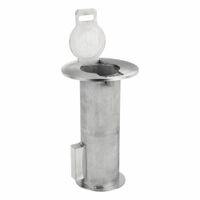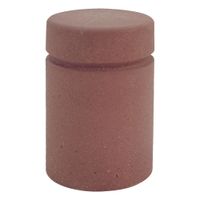Call +(254) 703 030 000 / 751 483 999 / 721 704 777
- Home
- Security
- Access Barriers Crowd Control
- Bollards Bollard Covers
.....Read More
Frequently Asked Questions
What are bollards used for?
Bollards are short, sturdy vertical posts used primarily for security, traffic management, and architectural purposes. They serve several key functions:
1. **Traffic Control**: Bollards are used to guide vehicular and pedestrian traffic. They can delineate lanes, prevent vehicles from entering restricted areas, and protect pedestrians by creating a physical barrier between sidewalks and roads.
2. **Security**: In security applications, bollards are installed to prevent vehicle-ramming attacks. They are often placed in front of buildings, pedestrian zones, and sensitive areas to stop unauthorized vehicle access and protect against potential threats.
3. **Property Protection**: Bollards protect infrastructure and property from accidental damage by vehicles. They are commonly found in parking lots, around utility installations, and near storefronts to prevent cars from crashing into structures.
4. **Aesthetic and Architectural Enhancement**: Bollards can enhance the visual appeal of a space. Available in various designs and materials, they can complement the architectural style of a building or area, serving both functional and decorative purposes.
5. **Temporary and Removable Barriers**: Some bollards are designed to be removable or retractable, allowing for flexible use of space. These are often used in areas that require occasional vehicle access, such as event spaces or pedestrian zones that convert to roads.
6. **Maritime Use**: In maritime contexts, bollards are used on docks and wharves to secure ships and boats. They provide a strong point for mooring lines, ensuring vessels remain safely anchored.
Overall, bollards are versatile tools that contribute to safety, security, and the organization of public and private spaces.
How do bollards protect pedestrians and property?
Bollards are short, sturdy posts installed to create a protective barrier, primarily used to safeguard pedestrians and property from vehicular traffic. They serve multiple protective functions:
1. **Physical Barrier**: Bollards act as a physical barrier that prevents vehicles from entering pedestrian zones, sidewalks, and other restricted areas. By doing so, they protect pedestrians from accidental or intentional vehicle intrusions.
2. **Traffic Control**: Strategically placed bollards guide traffic flow, ensuring vehicles remain on designated paths. This reduces the risk of accidents in areas with high pedestrian activity, such as shopping centers, parks, and urban streets.
3. **Impact Resistance**: Many bollards are designed to withstand significant impact. High-security bollards, often made of steel or concrete, can stop or slow down vehicles, preventing them from reaching sensitive areas or causing harm.
4. **Property Protection**: Bollards protect buildings and infrastructure from vehicular damage. They are often installed near storefronts, utility installations, and public buildings to prevent vehicles from crashing into these structures.
5. **Aesthetic and Functional Design**: While providing security, bollards can also enhance the aesthetic appeal of an area. They come in various designs and materials, allowing them to blend with the environment while serving their protective function.
6. **Deterrence**: The presence of bollards can deter potential threats by making it clear that vehicle access is restricted. This is particularly important in areas vulnerable to vehicle-based attacks.
7. **Safety Enhancement**: By delineating pedestrian zones from vehicular areas, bollards contribute to a safer environment, reducing the likelihood of accidents and enhancing the overall sense of security for pedestrians.
In summary, bollards are a crucial element in urban planning and security, providing a robust solution for protecting both people and property from vehicular threats.
What materials are bollards made from?
Bollards are constructed from a variety of materials, each chosen for specific functional and aesthetic purposes. Common materials include:
1. **Steel**: Known for its strength and durability, steel bollards are often used in high-security areas. They can be filled with concrete for added strength and are typically coated to prevent rust and corrosion.
2. **Concrete**: These bollards are robust and can withstand significant impact, making them ideal for areas requiring high security. They are often used in urban environments and can be reinforced with steel for additional strength.
3. **Plastic**: Lightweight and cost-effective, plastic bollards are often used for temporary or low-impact applications. They are typically made from high-density polyethylene (HDPE) and can be filled with sand or water for stability.
4. **Aluminum**: Offering a balance between strength and weight, aluminum bollards are resistant to corrosion and are often used in decorative applications. They are less robust than steel or concrete but provide a sleek, modern appearance.
5. **Wood**: Used primarily for aesthetic purposes, wooden bollards are common in parks and historical areas. They offer a natural look but require regular maintenance to prevent decay and damage from the elements.
6. **Cast Iron**: These bollards are durable and often used in historical or decorative settings. They can be ornate and are typically coated to prevent rust.
7. **Stainless Steel**: Known for its corrosion resistance and modern appearance, stainless steel bollards are used in both functional and decorative applications. They are often found in urban and coastal environments.
8. **Polyurethane**: Flexible and impact-resistant, polyurethane bollards are used in areas where vehicle impact is a concern. They can bend upon impact and return to their original shape.
Each material offers distinct advantages, making bollards versatile for various applications, from traffic control to security and aesthetic enhancement.
How do decorative bollards enhance aesthetic appeal?
Decorative bollards enhance aesthetic appeal by serving as functional art pieces that blend safety with visual interest. They transform mundane urban elements into attractive features that complement the surrounding architecture and landscape. By incorporating various materials such as cast iron, stainless steel, or stone, and finishes like paint or powder coating, decorative bollards can match or contrast with existing design themes, adding depth and character to public spaces.
Their design versatility allows them to reflect cultural or historical motifs, reinforcing local identity and heritage. For instance, bollards with intricate patterns or emblems can echo traditional craftsmanship, while sleek, modern designs can align with contemporary urban aesthetics. This adaptability makes them suitable for diverse environments, from historic districts to modern cityscapes.
Moreover, decorative bollards can be customized with lighting elements, planters, or seating, enhancing their functionality and visual appeal. Illuminated bollards provide ambient lighting, improving nighttime visibility and safety while creating a welcoming atmosphere. Bollards with integrated planters introduce greenery, softening hardscapes and contributing to environmental sustainability.
In addition to their aesthetic contributions, decorative bollards serve practical purposes by delineating spaces, guiding pedestrian flow, and protecting pedestrians and infrastructure from vehicular traffic. Their presence can subtly influence the perception of a space, making it feel more organized, secure, and inviting.
Overall, decorative bollards are a cost-effective way to enhance urban aesthetics, offering a harmonious blend of form and function that enriches the visual and experiential quality of public spaces.
What is the purpose of bollard covers?
Bollard covers serve multiple purposes, enhancing both the functionality and aesthetics of bollards. Primarily, they protect bollards from environmental wear and tear, such as rust, corrosion, and physical damage, thereby extending their lifespan. By covering bollards, these covers reduce maintenance costs and the need for frequent repainting or repairs.
Aesthetically, bollard covers offer an opportunity to improve the visual appeal of bollards. Available in various colors, designs, and materials, they can be customized to match the surrounding environment or corporate branding, contributing to a cohesive look in public spaces, commercial areas, or private properties.
Bollard covers also enhance safety by increasing visibility. Brightly colored or reflective covers make bollards more noticeable to pedestrians and drivers, reducing the risk of accidents. This is particularly important in areas with high foot or vehicle traffic, where bollards serve as protective barriers.
Additionally, bollard covers can be used for temporary or seasonal purposes. They can be easily swapped out to reflect different themes, holidays, or events, providing a versatile solution for changing decor without the need for permanent alterations.
In summary, bollard covers protect bollards from damage, enhance their appearance, improve safety by increasing visibility, and offer flexibility for temporary or seasonal changes.
How do planter bollards work?
Planter bollards are multifunctional urban design elements that combine the features of traditional bollards with planters. They serve both aesthetic and practical purposes in public spaces.
Structurally, planter bollards are typically composed of a sturdy base, often made from materials like steel, concrete, or cast iron, which provides the necessary strength to function as a bollard. This base is designed to withstand impact, thereby serving as a protective barrier against vehicles. The upper portion of the bollard is a planter, which can be filled with soil and plants. This dual functionality allows them to delineate pedestrian areas, control traffic flow, and enhance the visual appeal of streetscapes.
The working mechanism of planter bollards involves their strategic placement in urban environments. They are often installed along sidewalks, pedestrian zones, and building perimeters to prevent unauthorized vehicle access while allowing pedestrian movement. The weight and design of the bollard base ensure stability, even when the planter is filled with soil and plants.
Planter bollards also contribute to environmental and social benefits. The plants within the bollards can improve air quality, provide shade, and create a more inviting atmosphere. They can be used to introduce greenery into urban areas where traditional planting might not be feasible. Additionally, the presence of plants can have a calming effect on pedestrians and contribute to the overall well-being of the community.
In summary, planter bollards work by combining the protective function of bollards with the aesthetic and environmental benefits of planters, making them a versatile solution for urban design challenges.
Where are bollards typically installed?
Bollards are typically installed in a variety of locations to serve different purposes, including:
1. **Pedestrian Areas**: To protect pedestrians from vehicular traffic, bollards are often placed at the edges of sidewalks, pedestrian zones, and crosswalks.
2. **Parking Lots**: They are used to delineate parking spaces, guide traffic flow, and protect structures from accidental vehicle impact.
3. **Building Perimeters**: Bollards are installed around the perimeters of buildings to prevent vehicles from crashing into structures, providing security against both accidental and intentional impacts.
4. **Storefronts**: To protect against ram-raiding, bollards are placed in front of store entrances and windows.
5. **Public Spaces**: In parks, plazas, and other public areas, bollards help manage pedestrian and vehicle interactions, ensuring safety and accessibility.
6. **Roadways**: On roads, bollards are used to separate lanes, control traffic flow, and prevent illegal parking or driving on sidewalks.
7. **Industrial Sites**: To protect equipment and infrastructure, bollards are installed in warehouses, factories, and loading docks.
8. **Bike Lanes**: Bollards are used to separate bike lanes from vehicle traffic, enhancing cyclist safety.
9. **Event Venues**: Temporary or removable bollards are used to control access and manage crowds during events.
10. **Security Zones**: In high-security areas, such as government buildings and embassies, bollards are part of security measures to prevent unauthorized vehicle access.
11. **Marinas and Docks**: Bollards are used to secure boats and manage pedestrian traffic along docks.
12. **Airports and Train Stations**: To control vehicle access and protect passengers, bollards are strategically placed around terminals and platforms.
These installations are designed to enhance safety, security, and traffic management in both urban and rural settings.




